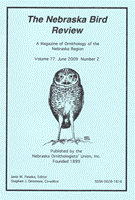Nebraska Ornithologists' Union

Nebraska Bird Review
Date of this Version
9-2005
Document Type
Article
Citation
“Summer Field Report, June–July 2005” from Nebraska Bird Review (September 2005) 73(3).
Abstract
The highlights of this season revolve around the excellent wetland habitat that existed in the eastern Rainwater Basin as a result of two things: a period of good rains in May and playa wetlands that have undergone restoration. The latter involves removal of accumulated silt and woody vegetation. Silt removal allows for germination of plants of the native soil bank in the original impervious pan, as well as somewhat deeper and more stable water conditions. These conditions resulted in several important breeding records, such as Pied-billed Grebe, American Coot, Northern Shoveler, and especially Black-necked Stilt. The good water conditions no doubt allowed waterfowl to linger, most unexpectedly Ring-necked Duck and Greater Scaup. Also related to the quality habitat were the increased numbers of lingering shorebirds, probably those which for several reasons may not have completed their northward migration. (Late shorebirds were at L Mcconaughy also, no doubt for similar reasons.) The removal of woody vegetation at Rainwater Basin wetlands is likely a contributor to the increasing numbers of Greater Prairie-Chicken and Henslow's Sparrow occurring in extensive grassland areas, not necessarily restricted to areas with native grassland species.
There is a clear increase in numbers of southern breeders in Nebraska such as Scissor-tailed Flycatcher and Northern Mockingbird, and White-winged Dove appears to be on the verge of becoming a Nebraska breeding species, if it has not already (see account). A major westward movement of Dickcissels was noted; western birders were quite excited to see this species in such numbers, although, as is typical in the west, they disappeared fairly early, perhaps without breeding.
The work being done by Rocky Mountain Bird Observatory personnel with Mountain Plovers and western Sandhills prairie birds, both efforts essentially on private lands, is encouraging. Mountain Plover nests were located and marked, with permission of the land owners, so that disking of fallow wheat ground did not destroy the nests. A surprisingly large number of nests was found in Kimball County, as well as one in Banner County; productivity was good for these nests. An intriguing find in Sheridan County was a Marbled Godwit nest, one of very few records for the state, but raising the possibility that this species indeed breeds in Nebraska in the vast, remote, and rarely accessed grasslands of the western Sandhills.
Finally, various NEBirds posts highlighted the concept that hummingbirds that show up from late July to early August are very likely not Ruby-throateds, which do not appear until mid- or late August. Although this is no surprise to western birders, observers in central and eastern Nebraska at locations where hummers were not seen during the summer should carefully scrutinize any hummer that appears in late Jul–early August.


Comments
Copyright 2005 Nebraska Ornithologists’ Union. Used by permission.